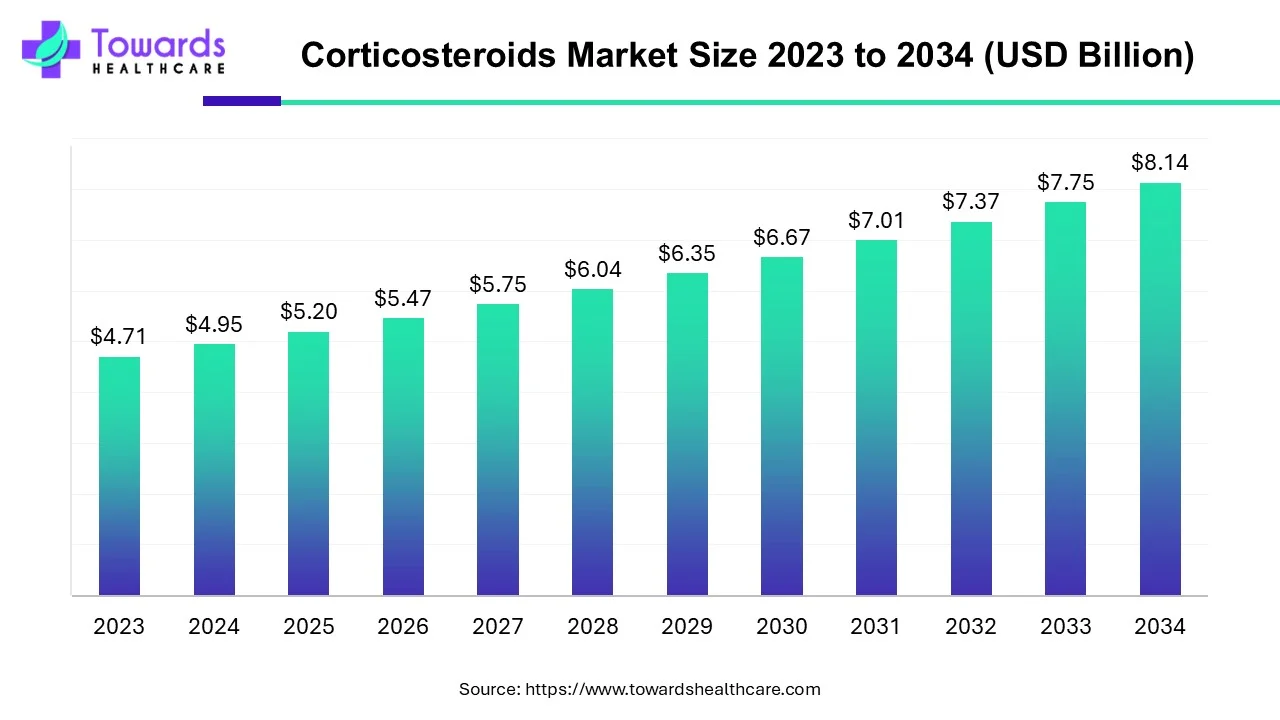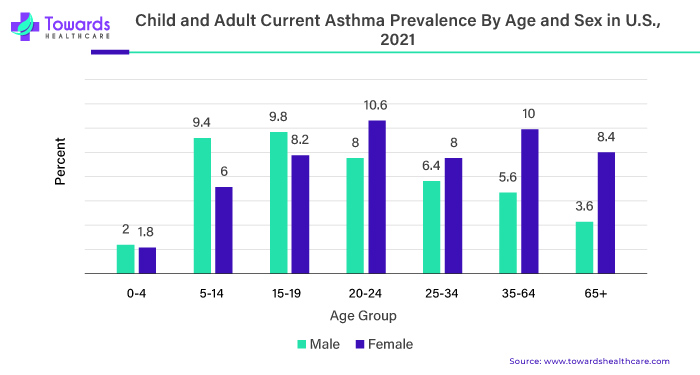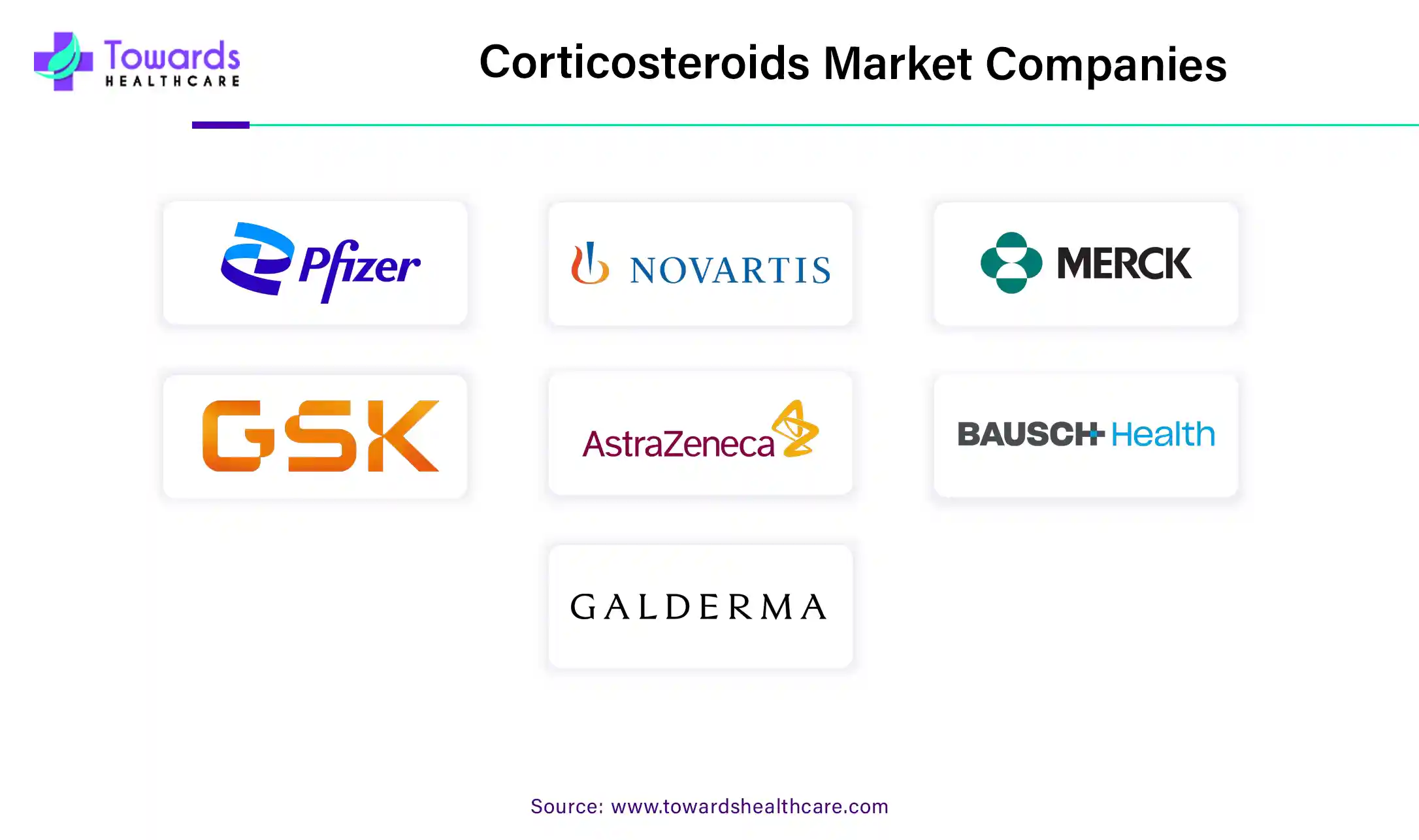March 2025

.webp)
Principal Consultant

Reviewed By
The corticosteroids market is forecasted to expand from USD 5.2 billion in 2025 to USD 8.14 billion by 2034, growing at a CAGR of 5.1% from 2025 to 2034.

The Forum of International Respiratory Societies estimates that over 4.5 million people have lost their lives due to the current pandemic, primarily from respiratory issues. Corticosteroids have been widely employed in treating respiratory diseases during this crisis.
Corticosteroids are a class of steroid hormones produced by the adrenal cortex, the outer portion of the adrenal glands located on top of each kidney. These hormones regulate various physiological processes, including metabolism, immune response, and electrolyte balance. There are two main types of corticosteroids: glucocorticoids and mineralocorticoids. Glucocorticoids, such as cortisol, regulate metabolism and the immune system, while mineralocorticoids, such as aldosterone, play a role in maintaining electrolyte and water balance.
In medicine, synthetic corticosteroids are commonly used for their anti-inflammatory and immunosuppressive properties. These medications are referred to as corticosteroid drugs or simply steroids. They can be administered in various forms, including oral tablets, topical creams or ointments, inhaled preparations, and injections. Corticosteroids are prescribed to treat a wide range of medical conditions, including autoimmune disorders, allergies, asthma, inflammatory joint diseases, and certain skin conditions.
It's important to note that healthcare professionals should carefully monitor the use of corticosteroids due to potential side effects and the need for appropriate dosage adjustments. Prolonged or inappropriate use of corticosteroids can lead to adverse effects such as bone loss, immune system suppression, and metabolic disturbances. Therefore, these medications are typically prescribed based on a thorough assessment of the patient's condition and careful consideration of the potential risks and benefits.
The increasing incidence of respiratory conditions, such as asthma and chronic obstructive pulmonary disease (COPD), has led to a higher demand for inhaled corticosteroids as part of the treatment regimen for these conditions. Corticosteroids continue to be a component of cancer treatment protocols, helping to manage side effects associated with chemotherapy. As cancer research advances and new treatment modalities emerge, the demand for supportive medications like corticosteroids may increase.
The pharmaceutical industry, along with various others, has been significantly impacted by the COVID-19 pandemic. Despite corticosteroids not being antiviral drugs, they have emerged as crucial components in the treatment of severe COVID-19 cases, particularly in individuals experiencing serious lung complications. The heightened demand for corticosteroids during the pandemic can be attributed to several key factors. One pivotal role of corticosteroids is managing cytokine storms, which are intense immune responses triggered in severe COVID-19 cases. By modulating the immune system, corticosteroids help control these storms, reducing inflammation and safeguarding vital organs.
Additionally, the pandemic has seen an increase in cases of Acute Respiratory Distress Syndrome (ARDS) induced by COVID-19, characterized by severe lung inflammation. Corticosteroids alleviate this inflammation and enhance respiratory function in critically ill patients. Evidence from various clinical trials, including the influential RECOVERY trial, has supported using corticosteroids in severe COVID-19 cases. Notably, medications like dexamethasone have demonstrated effectiveness in reducing mortality rates, particularly in patients requiring respiratory support.
For instance,
Major health organizations, including the World Health Organization (WHO) and the Centers for Disease Control and Prevention (CDC), have responded to emerging evidence by updating their guidelines. These updates now recommend corticosteroids for specific severe cases of COVID-19, further contributing to the increased demand.
Many countries granted emergency approvals for using corticosteroids to address the urgency of treating severe COVID-19 cases. This facilitated quicker access to these medications for healthcare providers on the front lines of patient care. The surge in COVID-19 cases and subsequent hospitalizations during various waves of the pandemic heightened the demand for medications, including corticosteroids. Hospitals and healthcare systems proactively stocked up on these drugs to meet the needs of critically ill patients requiring intensive care.
The pandemic's challenges have led to a boost in research efforts to understand the immune response to the virus better and identify effective treatment strategies. Corticosteroids have been explored in these research endeavors, being considered a valuable component in the evolving treatment plans against COVID-19.
Pulmonology's application of corticosteroids, involving inhaling these medications directly into the lungs, is widely employed in managing respiratory conditions like asthma and chronic obstructive pulmonary disease (COPD). This approach holds significant potential to drive the growth of the corticosteroid market for several compelling reasons.
For instance,

One key advantage of pulmonary application is its ability to provide localized treatment, delivering corticosteroids directly to the lungs where inflammation commonly occurs in respiratory conditions. This targeted delivery minimizes systemic exposure, mitigating the risk of systemic side effects while maximizing the therapeutic impact precisely at the site of inflammation. Compared to systemic administration methods, such as oral or injectable forms, inhaled corticosteroids generally exhibit lower systemic absorption. This characteristic reduces systemic side effects, such as bone loss or immune system suppression, making inhaled corticosteroids a preferred option for long-term use in chronic respiratory conditions.
Inhaled corticosteroids play a pivotal role in effectively managing inflammation within the airways, a fundamental aspect of respiratory diseases like asthma and COPD.
For instance,
This efficacy translates into improved symptom control, reduced exacerbations, and enhanced lung function. The convenience and patient-friendly nature of inhaled corticosteroids, typically administered through inhalers, contribute to increased patient compliance with prescribed treatment regimens. This adherence is crucial for effectively managing chronic respiratory conditions. The success of inhaled corticosteroids in managing respiratory conditions has prompted ongoing research into their potential application in other pulmonary disorders. This exploration could lead to an expanded range of indications for inhaled corticosteroids, further amplifying their demand in the market.
Combination therapies, wherein inhaled corticosteroids are paired with other respiratory medications like long-acting beta-agonists, offer a comprehensive approach to managing respiratory conditions. This integration contributes to the diversity of the market for respiratory medicines.
| Sr. No. | Combination Therapy | Indication |
| 1. | Inhaled corticosteroids (ICS) with long-acting bronchodilators (LABA) | This combination is frequently used for asthma. The LABA opens airways while the ICS reduces inflammation. Examples include fluticasone/salmeterol (Advair) and budesonide/formoterol (Symbicort). |
| 2. | ICS with long-acting muscarinic antagonists (LAMA) | This combination is commonly used for chronic obstructive pulmonary disease (COPD), another type of inflammatory lung disease. It targets different aspects of airway relaxation compared to ICS/LABA. Examples include fluticasone/umeclidinium/vilanterol (Trivento) and beclomethasone/glycopyrrolate/formoterol (Breztri Aerosphere). |
| 3. | Systemic Corticosteroids | These are typically used for short-term management of severe exacerbations of various pulmonary diseases, including asthma and COPD. They reduce inflammation but have more side effects than inhaled corticosteroids. |
| 4. | Triple Therapy | Combining ICS, LABA, and LAMA is sometimes used for patients with severe or poorly controlled COPD. This approach targets multiple mechanisms involved in the disease. |
As respiratory conditions remain prevalent worldwide, the demand for targeted and effective treatments like inhaled corticosteroids is expected to drive the growth of the corticosteroid market. Ongoing developments in formulations, devices, and combination therapies further enhance the market potential for the pulmonary application of corticosteroids.
The cost of corticosteroid medications, used to treat various medical conditions, can differ from one type of medication to another. Some newer versions or combinations of these medications might be more expensive. This can worry patients because if the medicines are too costly, it might be challenging to afford and get the treatment they need.
Imagine if you have a health issue requiring corticosteroids, and different options are available. Some of these options might be more advanced or combined with other medications to make the treatment more effective. However, these newer or combined versions might be pricier than the older ones.
For instance,
Affordability is a concern because if the medication is too expensive, some people might have trouble paying for it. This, in turn, can affect their ability to access the necessary treatment. Healthcare providers and policymakers need to consider these cost factors to ensure that people can afford the medications they need for their health. This way, everyone has a fair chance to get the treatment that can help them feel better without facing financial difficulties.
North America boasts a well-developed healthcare infrastructure with advanced medical facilities, research institutions, and a high standard of healthcare delivery. This infrastructure supports diagnosing, treating, and managing a wide range of conditions, contributing to the demand for corticosteroid medications. Respiratory conditions, such as asthma and chronic obstructive pulmonary disease (COPD), are prevalent in North America. The region's corticosteroid market is significantly influenced by the demand for inhaled corticosteroids, commonly prescribed for managing these respiratory disorders. Respiratory conditions, such as asthma and chronic obstructive pulmonary disease (COPD), are prevalent in North America. The region's corticosteroid market is significantly influenced by the demand for inhaled corticosteroids, commonly prescribed for managing these respiratory disorders. The ongoing collaboration between healthcare stakeholders, including government agencies, healthcare providers, and the pharmaceutical industry, continues to influence the landscape and ensure the effective use of corticosteroids in patient care.
The Asia-Pacific region is home to a large and diverse population, including developed and emerging economies. The sheer size and diversity of the population contribute to a significant market for corticosteroid medications to address various health needs. The region is witnessing increased research and development initiatives in the pharmaceutical sector. Ongoing efforts focus on developing new formulations, combination therapies, and targeted corticosteroid delivery methods, contributing to market growth. Some countries in the Asia-Pacific region are considered emerging markets for pharmaceuticals. The growing middle class, urbanization, and increasing healthcare investments create opportunities to expand the corticosteroid market.
The competitive landscape for the corticosteroid market is shaped by a mix of global pharmaceutical companies, regional players, and a diverse range of corticosteroid products catering to various therapeutic areas. Companies in the corticosteroid market offer a diverse range of products, including oral tablets, topical creams, ointments, nasal sprays, inhalers, and injectables. This diverse portfolio allows them to address various medical conditions, from skin disorders to respiratory and autoimmune diseases. Understanding the competitive landscape involves considering the intricate balance between innovation, market expansion, regulatory compliance, and strategic partnerships. Companies that effectively navigate these factors are well-positioned to thrive in the corticosteroid market.

By Product Type
By Route of Administration
By Application
By Product Form
By End User
By Geography
March 2025
March 2025
March 2025
March 2025